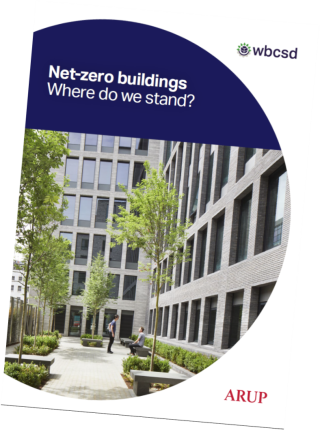Fewer than 1% of building projects currently calculate and report their full carbon footprint, says a report by Arup and the World Business Council for Sustainable Development (WBCSD).
The building industry is responsible for 38%, or around 14 gigatons, of all energy-related greenhouse gas emissions each year. Global decarbonization trajectories indicate that the industry needs to reduce these emissions by 50% by 2030 if it is to reach net zero by mid-century and achieve the climate goals of the Paris Agreement.
The report authors claim that the vast majority of buildings currently do not receive an assessment of the carbon footprint across the whole life cycle. The industry has only focused on measuring and reducing operational energy use and the carbon associated with it. However, the report says we should be measuring the embodied carbon associated with construction, refurbishment and end of life as part of the building's whole life-cycle footprint. The report studied six modern buildings and found as much as 50% of the whole life carbon emissions came from embodied carbon.
Given the industry’s overall contribution to global greenhouse gas emissions, and the necessity to rapidly and systematically decrease these, the authors argue that the industry must understand much more clearly ‘where it stands’ with regards to each building delivered. Clear targets and collaboration are crucial to achieving progress.
Using the WBCSD Building System Carbon Framework, the report outlines whole life carbon assessments (WLCA) of six case studies representing what might be considered best practice buildings today. Based on these case studies and a discussion of emerging benchmarks in some markets, the authors estimate that by setting explicit targets from the start of a building project and through collaboration along the value chain, emissions could be halved in every building project by 2030.
The six case studies found:

- An average whole life carbon footprint of 1,800 kgCO2e/m2 was estimated across the six case studies.
- As much as 50% of whole life carbon emissions in a building comes from embodied carbon (manufacturing of materials and the construction process) the majority of this being emitted immediately at the start of the life-cycle.
- Typically as few as six materials account for 70% of the construction-related embodied carbon.
Chris Caroll, building engineering director at consulting engineer Arup and one of the report authors, said: “We have to consider carbon like we currently consider money. The idea that you would build a project and not know how much it costs financially would seem incredible. But the industry currently doesn’t know where it stands when it comes to carbon emissions, making it difficult to set meaningful targets and drive progress. We must see more data sharing, more collaboration and transparency to be able to achieve the decarbonization that the world demands of us in the next few decades.”
Roland Hunziker, director for sustainable buildings & cities at WBCSD, said: “To get the construction industry on track to reach global climate targets, all companies need to start measuring the full carbon footprint of their real estate assets. This report builds on WBCSD’s Building System Carbon Framework, which helps companies understand where emissions occur all along the value chain and how they can work together to reduce them. The report shows that if all parties in the building value chain collaborate and focus on whole life carbon emissions reductions, we can start setting this important sector on a path towards net zero.”
The authors of the report recommend some key actions for the industry to make progress towards net-zero:
- Carry out whole life carbon assessments on all projects, using a consistent methodology and open-source sharing of the data obtained
- Develop consistent and transparent carbon intensity data for components, systems and materials used by the industry
- Commit to clear global targets across the buildings industry, including a valid approach to residual emissions (offsetting)
- Adopt a clear definition of a net-zero building, taking into account whole life-cycle carbon
- Achieve wider collaboration as individual organizations taking action is not enough.
Net-zero buildings: Where do we stand? Can be downloaded at www.wbcsd.org
Got a story? Email news@theconstructionindex.co.uk
.png)



